A Comprehensive Report on Criminal Law Defenses and Their Application
VerifiedAdded on 2022/09/12
|12
|2609
|56
Report
AI Summary
This report provides a detailed analysis of various defenses within the realm of criminal law. It begins by differentiating between general and complete defenses, followed by an examination of the M'Naghten Rules, including their strengths and weaknesses. The report then delves into the nuances of automatism and insanity defenses, highlighting their similarities and differences, along with the scope of the automatism defense. A key section evaluates several defenses, such as duress of threats, duress of circumstances, necessity, and self-defense, outlining their respective scopes. Furthermore, the report discusses the strengths and weaknesses of the mistake defense, differentiates between specific and basic intent crimes, and evaluates voluntary and involuntary intoxication. The analysis concludes by examining the limitations of the defenses of consent and infancy. The report draws upon legal cases and concepts to provide a comprehensive understanding of these crucial elements of criminal law.

Law CBF750
Running Head: Law CBF750 0
4 / 7 / 2 0 2 0
Student’s Name
Running Head: Law CBF750 0
4 / 7 / 2 0 2 0
Student’s Name
Paraphrase This Document
Need a fresh take? Get an instant paraphrase of this document with our AI Paraphraser

Law CBF750 1
Contents
Introduction.................................................................................................................................................2
Section 1......................................................................................................................................................2
Section 2......................................................................................................................................................2
Section 3......................................................................................................................................................3
Section 4......................................................................................................................................................4
Section 5......................................................................................................................................................4
Section 6......................................................................................................................................................6
Section 7......................................................................................................................................................6
Section 8......................................................................................................................................................7
Section 9......................................................................................................................................................8
Conclusion...................................................................................................................................................9
References.................................................................................................................................................10
Contents
Introduction.................................................................................................................................................2
Section 1......................................................................................................................................................2
Section 2......................................................................................................................................................2
Section 3......................................................................................................................................................3
Section 4......................................................................................................................................................4
Section 5......................................................................................................................................................4
Section 6......................................................................................................................................................6
Section 7......................................................................................................................................................6
Section 8......................................................................................................................................................7
Section 9......................................................................................................................................................8
Conclusion...................................................................................................................................................9
References.................................................................................................................................................10
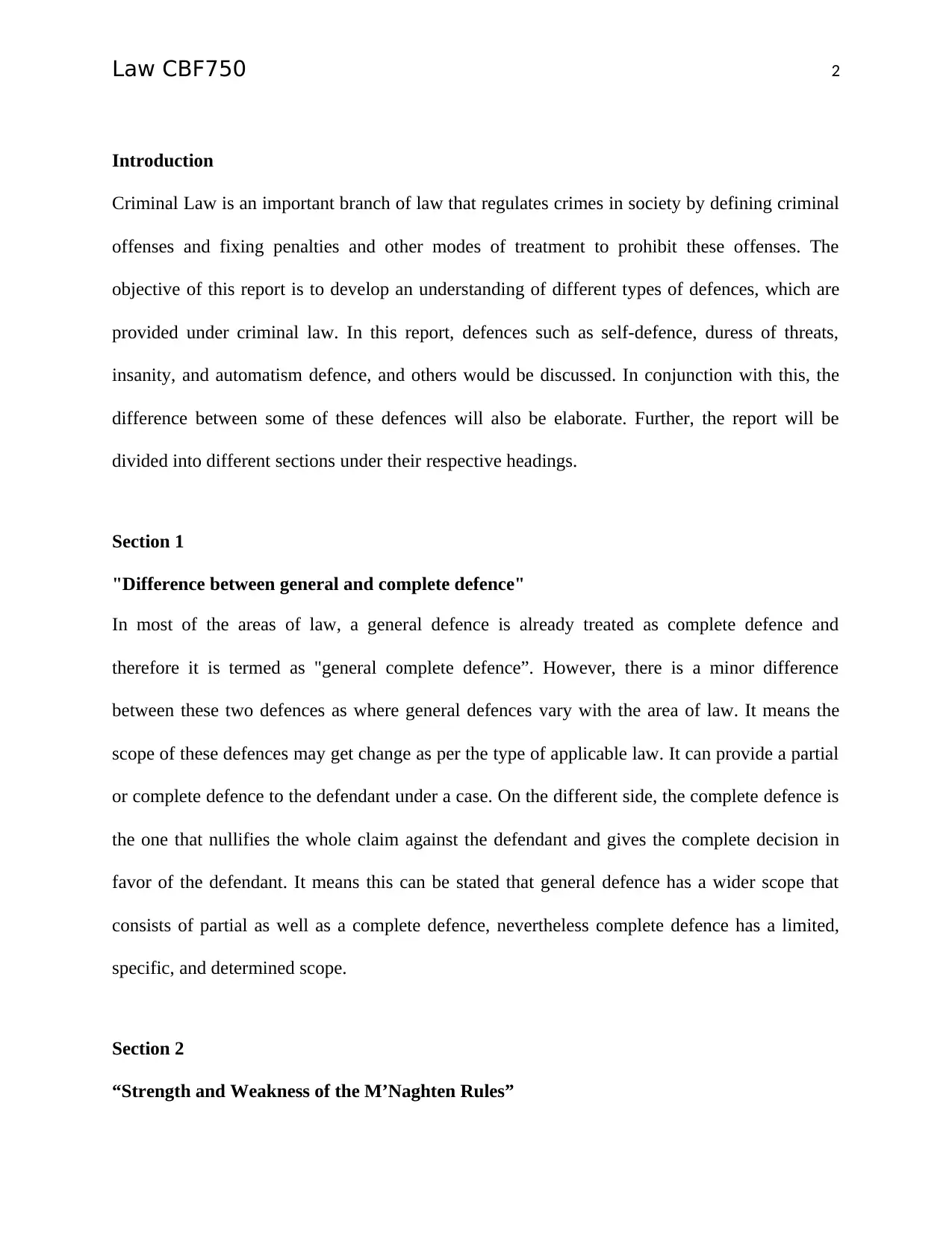
Law CBF750 2
Introduction
Criminal Law is an important branch of law that regulates crimes in society by defining criminal
offenses and fixing penalties and other modes of treatment to prohibit these offenses. The
objective of this report is to develop an understanding of different types of defences, which are
provided under criminal law. In this report, defences such as self-defence, duress of threats,
insanity, and automatism defence, and others would be discussed. In conjunction with this, the
difference between some of these defences will also be elaborate. Further, the report will be
divided into different sections under their respective headings.
Section 1
"Difference between general and complete defence"
In most of the areas of law, a general defence is already treated as complete defence and
therefore it is termed as "general complete defence”. However, there is a minor difference
between these two defences as where general defences vary with the area of law. It means the
scope of these defences may get change as per the type of applicable law. It can provide a partial
or complete defence to the defendant under a case. On the different side, the complete defence is
the one that nullifies the whole claim against the defendant and gives the complete decision in
favor of the defendant. It means this can be stated that general defence has a wider scope that
consists of partial as well as a complete defence, nevertheless complete defence has a limited,
specific, and determined scope.
Section 2
“Strength and Weakness of the M’Naghten Rules”
Introduction
Criminal Law is an important branch of law that regulates crimes in society by defining criminal
offenses and fixing penalties and other modes of treatment to prohibit these offenses. The
objective of this report is to develop an understanding of different types of defences, which are
provided under criminal law. In this report, defences such as self-defence, duress of threats,
insanity, and automatism defence, and others would be discussed. In conjunction with this, the
difference between some of these defences will also be elaborate. Further, the report will be
divided into different sections under their respective headings.
Section 1
"Difference between general and complete defence"
In most of the areas of law, a general defence is already treated as complete defence and
therefore it is termed as "general complete defence”. However, there is a minor difference
between these two defences as where general defences vary with the area of law. It means the
scope of these defences may get change as per the type of applicable law. It can provide a partial
or complete defence to the defendant under a case. On the different side, the complete defence is
the one that nullifies the whole claim against the defendant and gives the complete decision in
favor of the defendant. It means this can be stated that general defence has a wider scope that
consists of partial as well as a complete defence, nevertheless complete defence has a limited,
specific, and determined scope.
Section 2
“Strength and Weakness of the M’Naghten Rules”
⊘ This is a preview!⊘
Do you want full access?
Subscribe today to unlock all pages.

Trusted by 1+ million students worldwide
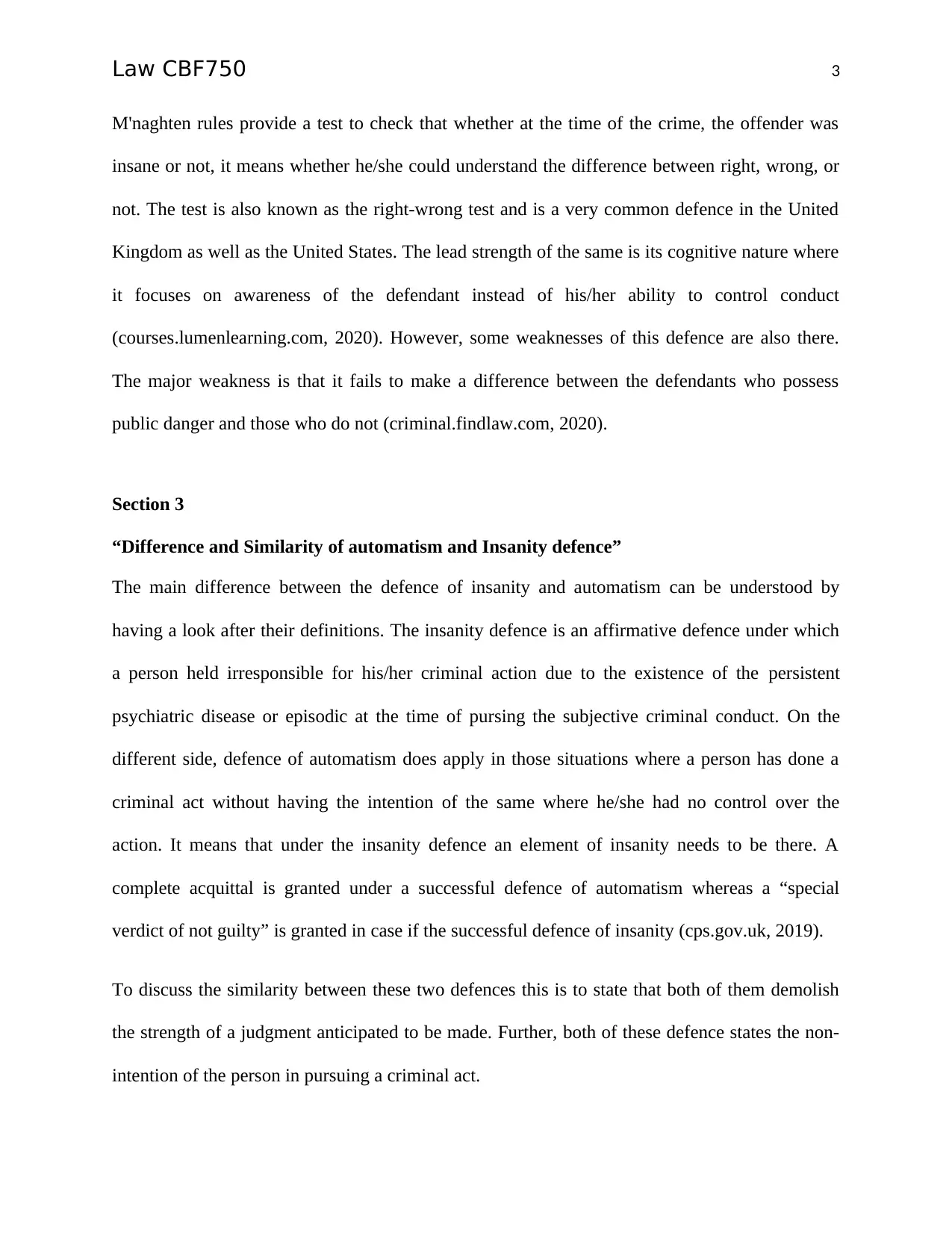
Law CBF750 3
M'naghten rules provide a test to check that whether at the time of the crime, the offender was
insane or not, it means whether he/she could understand the difference between right, wrong, or
not. The test is also known as the right-wrong test and is a very common defence in the United
Kingdom as well as the United States. The lead strength of the same is its cognitive nature where
it focuses on awareness of the defendant instead of his/her ability to control conduct
(courses.lumenlearning.com, 2020). However, some weaknesses of this defence are also there.
The major weakness is that it fails to make a difference between the defendants who possess
public danger and those who do not (criminal.findlaw.com, 2020).
Section 3
“Difference and Similarity of automatism and Insanity defence”
The main difference between the defence of insanity and automatism can be understood by
having a look after their definitions. The insanity defence is an affirmative defence under which
a person held irresponsible for his/her criminal action due to the existence of the persistent
psychiatric disease or episodic at the time of pursing the subjective criminal conduct. On the
different side, defence of automatism does apply in those situations where a person has done a
criminal act without having the intention of the same where he/she had no control over the
action. It means that under the insanity defence an element of insanity needs to be there. A
complete acquittal is granted under a successful defence of automatism whereas a “special
verdict of not guilty” is granted in case if the successful defence of insanity (cps.gov.uk, 2019).
To discuss the similarity between these two defences this is to state that both of them demolish
the strength of a judgment anticipated to be made. Further, both of these defence states the non-
intention of the person in pursuing a criminal act.
M'naghten rules provide a test to check that whether at the time of the crime, the offender was
insane or not, it means whether he/she could understand the difference between right, wrong, or
not. The test is also known as the right-wrong test and is a very common defence in the United
Kingdom as well as the United States. The lead strength of the same is its cognitive nature where
it focuses on awareness of the defendant instead of his/her ability to control conduct
(courses.lumenlearning.com, 2020). However, some weaknesses of this defence are also there.
The major weakness is that it fails to make a difference between the defendants who possess
public danger and those who do not (criminal.findlaw.com, 2020).
Section 3
“Difference and Similarity of automatism and Insanity defence”
The main difference between the defence of insanity and automatism can be understood by
having a look after their definitions. The insanity defence is an affirmative defence under which
a person held irresponsible for his/her criminal action due to the existence of the persistent
psychiatric disease or episodic at the time of pursing the subjective criminal conduct. On the
different side, defence of automatism does apply in those situations where a person has done a
criminal act without having the intention of the same where he/she had no control over the
action. It means that under the insanity defence an element of insanity needs to be there. A
complete acquittal is granted under a successful defence of automatism whereas a “special
verdict of not guilty” is granted in case if the successful defence of insanity (cps.gov.uk, 2019).
To discuss the similarity between these two defences this is to state that both of them demolish
the strength of a judgment anticipated to be made. Further, both of these defence states the non-
intention of the person in pursuing a criminal act.
Paraphrase This Document
Need a fresh take? Get an instant paraphrase of this document with our AI Paraphraser

Law CBF750 4
Section 4
“Scope of the defence of automatism”
There has been always a defence with respect to the scope of defence of automatism where some
of the people consider it narrows and some of them wider. Reviewing the arguments and key
point of both of the side, this is to seem that the scope if narrow. To prove an automatism, the
offender has to prove several factors such as the action were not self-induced, the action was
involuntary completely and others (inbrief.co.uk, 2020). In addition to this, to prove, Self-
induced automatism, again several factors are required to prove. This is the reason that in most of
the case, the defence is not granted. The defence excludes situations of self-induced automatism
as well as those situations where the offender could foresee his/her criminal act.
While determining the cases under this defence, courts often likely to use a narrow approach of
the scope. Sometimes the word “scepticism” has also been used. The case of Broome v Perkins
[1987] Crim LR 271 can be taken as an example here where the court held the driver guilty as he
was getting conscious control time to time and the defence of automatism has been rejected
stating that the action of the offender was totally out of his control. In this manner, it is clear that
the defence is narrow in actual what it refers to.
Section 5
“Evaluation of the various defences”
Several defences are allowed in criminal law where they can apply in different situations,
although not absolutely but as per the rules attached thereto. The four key defences and their
scope are mentioned as below:-
Section 4
“Scope of the defence of automatism”
There has been always a defence with respect to the scope of defence of automatism where some
of the people consider it narrows and some of them wider. Reviewing the arguments and key
point of both of the side, this is to seem that the scope if narrow. To prove an automatism, the
offender has to prove several factors such as the action were not self-induced, the action was
involuntary completely and others (inbrief.co.uk, 2020). In addition to this, to prove, Self-
induced automatism, again several factors are required to prove. This is the reason that in most of
the case, the defence is not granted. The defence excludes situations of self-induced automatism
as well as those situations where the offender could foresee his/her criminal act.
While determining the cases under this defence, courts often likely to use a narrow approach of
the scope. Sometimes the word “scepticism” has also been used. The case of Broome v Perkins
[1987] Crim LR 271 can be taken as an example here where the court held the driver guilty as he
was getting conscious control time to time and the defence of automatism has been rejected
stating that the action of the offender was totally out of his control. In this manner, it is clear that
the defence is narrow in actual what it refers to.
Section 5
“Evaluation of the various defences”
Several defences are allowed in criminal law where they can apply in different situations,
although not absolutely but as per the rules attached thereto. The four key defences and their
scope are mentioned as below:-
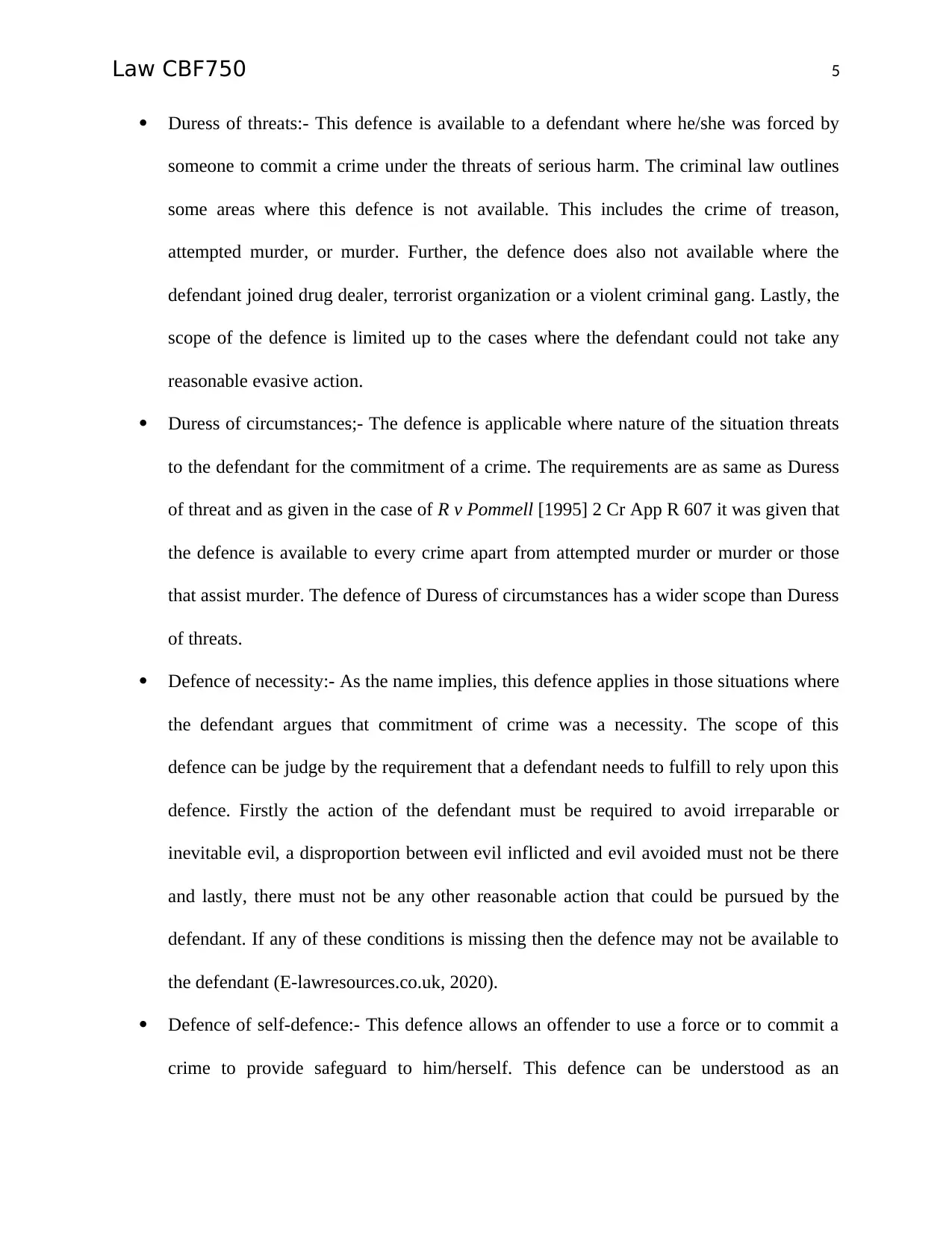
Law CBF750 5
Duress of threats:- This defence is available to a defendant where he/she was forced by
someone to commit a crime under the threats of serious harm. The criminal law outlines
some areas where this defence is not available. This includes the crime of treason,
attempted murder, or murder. Further, the defence does also not available where the
defendant joined drug dealer, terrorist organization or a violent criminal gang. Lastly, the
scope of the defence is limited up to the cases where the defendant could not take any
reasonable evasive action.
Duress of circumstances;- The defence is applicable where nature of the situation threats
to the defendant for the commitment of a crime. The requirements are as same as Duress
of threat and as given in the case of R v Pommell [1995] 2 Cr App R 607 it was given that
the defence is available to every crime apart from attempted murder or murder or those
that assist murder. The defence of Duress of circumstances has a wider scope than Duress
of threats.
Defence of necessity:- As the name implies, this defence applies in those situations where
the defendant argues that commitment of crime was a necessity. The scope of this
defence can be judge by the requirement that a defendant needs to fulfill to rely upon this
defence. Firstly the action of the defendant must be required to avoid irreparable or
inevitable evil, a disproportion between evil inflicted and evil avoided must not be there
and lastly, there must not be any other reasonable action that could be pursued by the
defendant. If any of these conditions is missing then the defence may not be available to
the defendant (E-lawresources.co.uk, 2020).
Defence of self-defence:- This defence allows an offender to use a force or to commit a
crime to provide safeguard to him/herself. This defence can be understood as an
Duress of threats:- This defence is available to a defendant where he/she was forced by
someone to commit a crime under the threats of serious harm. The criminal law outlines
some areas where this defence is not available. This includes the crime of treason,
attempted murder, or murder. Further, the defence does also not available where the
defendant joined drug dealer, terrorist organization or a violent criminal gang. Lastly, the
scope of the defence is limited up to the cases where the defendant could not take any
reasonable evasive action.
Duress of circumstances;- The defence is applicable where nature of the situation threats
to the defendant for the commitment of a crime. The requirements are as same as Duress
of threat and as given in the case of R v Pommell [1995] 2 Cr App R 607 it was given that
the defence is available to every crime apart from attempted murder or murder or those
that assist murder. The defence of Duress of circumstances has a wider scope than Duress
of threats.
Defence of necessity:- As the name implies, this defence applies in those situations where
the defendant argues that commitment of crime was a necessity. The scope of this
defence can be judge by the requirement that a defendant needs to fulfill to rely upon this
defence. Firstly the action of the defendant must be required to avoid irreparable or
inevitable evil, a disproportion between evil inflicted and evil avoided must not be there
and lastly, there must not be any other reasonable action that could be pursued by the
defendant. If any of these conditions is missing then the defence may not be available to
the defendant (E-lawresources.co.uk, 2020).
Defence of self-defence:- This defence allows an offender to use a force or to commit a
crime to provide safeguard to him/herself. This defence can be understood as an
⊘ This is a preview!⊘
Do you want full access?
Subscribe today to unlock all pages.

Trusted by 1+ million students worldwide
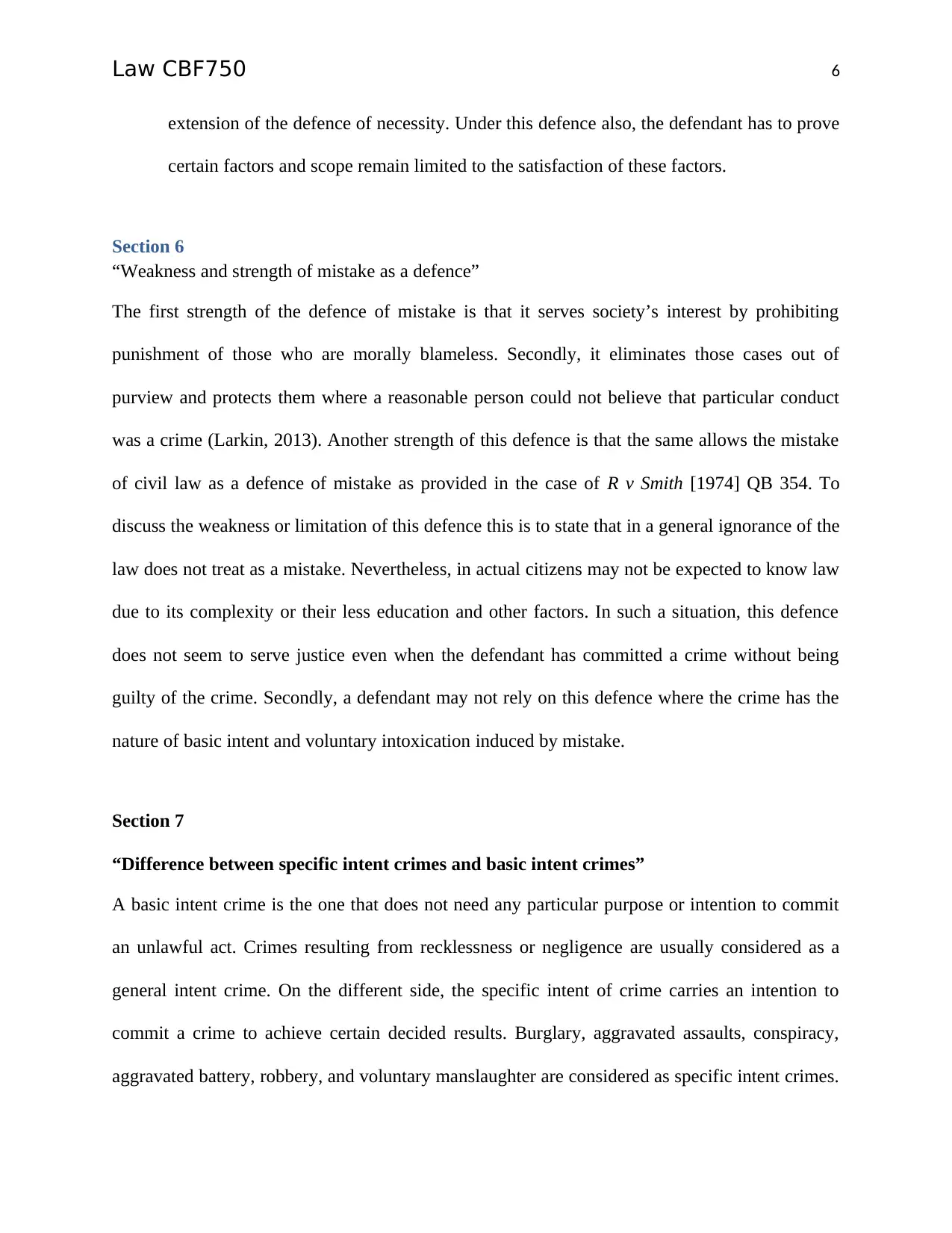
Law CBF750 6
extension of the defence of necessity. Under this defence also, the defendant has to prove
certain factors and scope remain limited to the satisfaction of these factors.
Section 6
“Weakness and strength of mistake as a defence”
The first strength of the defence of mistake is that it serves society’s interest by prohibiting
punishment of those who are morally blameless. Secondly, it eliminates those cases out of
purview and protects them where a reasonable person could not believe that particular conduct
was a crime (Larkin, 2013). Another strength of this defence is that the same allows the mistake
of civil law as a defence of mistake as provided in the case of R v Smith [1974] QB 354. To
discuss the weakness or limitation of this defence this is to state that in a general ignorance of the
law does not treat as a mistake. Nevertheless, in actual citizens may not be expected to know law
due to its complexity or their less education and other factors. In such a situation, this defence
does not seem to serve justice even when the defendant has committed a crime without being
guilty of the crime. Secondly, a defendant may not rely on this defence where the crime has the
nature of basic intent and voluntary intoxication induced by mistake.
Section 7
“Difference between specific intent crimes and basic intent crimes”
A basic intent crime is the one that does not need any particular purpose or intention to commit
an unlawful act. Crimes resulting from recklessness or negligence are usually considered as a
general intent crime. On the different side, the specific intent of crime carries an intention to
commit a crime to achieve certain decided results. Burglary, aggravated assaults, conspiracy,
aggravated battery, robbery, and voluntary manslaughter are considered as specific intent crimes.
extension of the defence of necessity. Under this defence also, the defendant has to prove
certain factors and scope remain limited to the satisfaction of these factors.
Section 6
“Weakness and strength of mistake as a defence”
The first strength of the defence of mistake is that it serves society’s interest by prohibiting
punishment of those who are morally blameless. Secondly, it eliminates those cases out of
purview and protects them where a reasonable person could not believe that particular conduct
was a crime (Larkin, 2013). Another strength of this defence is that the same allows the mistake
of civil law as a defence of mistake as provided in the case of R v Smith [1974] QB 354. To
discuss the weakness or limitation of this defence this is to state that in a general ignorance of the
law does not treat as a mistake. Nevertheless, in actual citizens may not be expected to know law
due to its complexity or their less education and other factors. In such a situation, this defence
does not seem to serve justice even when the defendant has committed a crime without being
guilty of the crime. Secondly, a defendant may not rely on this defence where the crime has the
nature of basic intent and voluntary intoxication induced by mistake.
Section 7
“Difference between specific intent crimes and basic intent crimes”
A basic intent crime is the one that does not need any particular purpose or intention to commit
an unlawful act. Crimes resulting from recklessness or negligence are usually considered as a
general intent crime. On the different side, the specific intent of crime carries an intention to
commit a crime to achieve certain decided results. Burglary, aggravated assaults, conspiracy,
aggravated battery, robbery, and voluntary manslaughter are considered as specific intent crimes.
Paraphrase This Document
Need a fresh take? Get an instant paraphrase of this document with our AI Paraphraser

Law CBF750 7
To discuss the further difference between these two crimes this is to state that proof of intent is
required in case of specific intent crime whereas merely proof of recklessness is required in case
of basic intent crime. It means a person may be held liable for the basic intent crime just by
pursuing that crime but in specific intent, they need to have an intention to do so
(legalmatch.com, 2020). Further, under basic intent crime, only the occurrence of crime needs to
be proved. Lastly, where the basic intent crime reflects the phrase “actus reus”, specific intent
crime refers to “Mens rea”.
Section 8
“Evaluation of Voluntary and involuntary intoxication”
Similar to the other defence discussed earlier in this report, the defence of voluntary and
involuntary intoxication is also necessary to discuss. Here this is to state that in general
intoxication is not treated as a defence of a crime nevertheless the level of intoxication prohibits
the development of mens rea to commit a crime. Here law strike a situation of imbalance where
it is hard to decide that whether to protect a person who was no intention to commit a crime yet
done do due to intoxication or whether to protect public from a person who deliberately put
him/herself in a condition where he/she was expected to lose the control.
Starting the discussion from voluntary intoxication defence, this is to state that voluntary
intoxication is a situation where a person knowingly makes him/herself intoxicated to a level
where he/she loses their mental capacity to judge a criminal act. Here the difference between
specific intent crime and basic intent crime emerges, as voluntary intoxication does never serve
as a defence for basic intent crimes. However, in case of specific intent crime, this defence can
To discuss the further difference between these two crimes this is to state that proof of intent is
required in case of specific intent crime whereas merely proof of recklessness is required in case
of basic intent crime. It means a person may be held liable for the basic intent crime just by
pursuing that crime but in specific intent, they need to have an intention to do so
(legalmatch.com, 2020). Further, under basic intent crime, only the occurrence of crime needs to
be proved. Lastly, where the basic intent crime reflects the phrase “actus reus”, specific intent
crime refers to “Mens rea”.
Section 8
“Evaluation of Voluntary and involuntary intoxication”
Similar to the other defence discussed earlier in this report, the defence of voluntary and
involuntary intoxication is also necessary to discuss. Here this is to state that in general
intoxication is not treated as a defence of a crime nevertheless the level of intoxication prohibits
the development of mens rea to commit a crime. Here law strike a situation of imbalance where
it is hard to decide that whether to protect a person who was no intention to commit a crime yet
done do due to intoxication or whether to protect public from a person who deliberately put
him/herself in a condition where he/she was expected to lose the control.
Starting the discussion from voluntary intoxication defence, this is to state that voluntary
intoxication is a situation where a person knowingly makes him/herself intoxicated to a level
where he/she loses their mental capacity to judge a criminal act. Here the difference between
specific intent crime and basic intent crime emerges, as voluntary intoxication does never serve
as a defence for basic intent crimes. However, in case of specific intent crime, this defence can
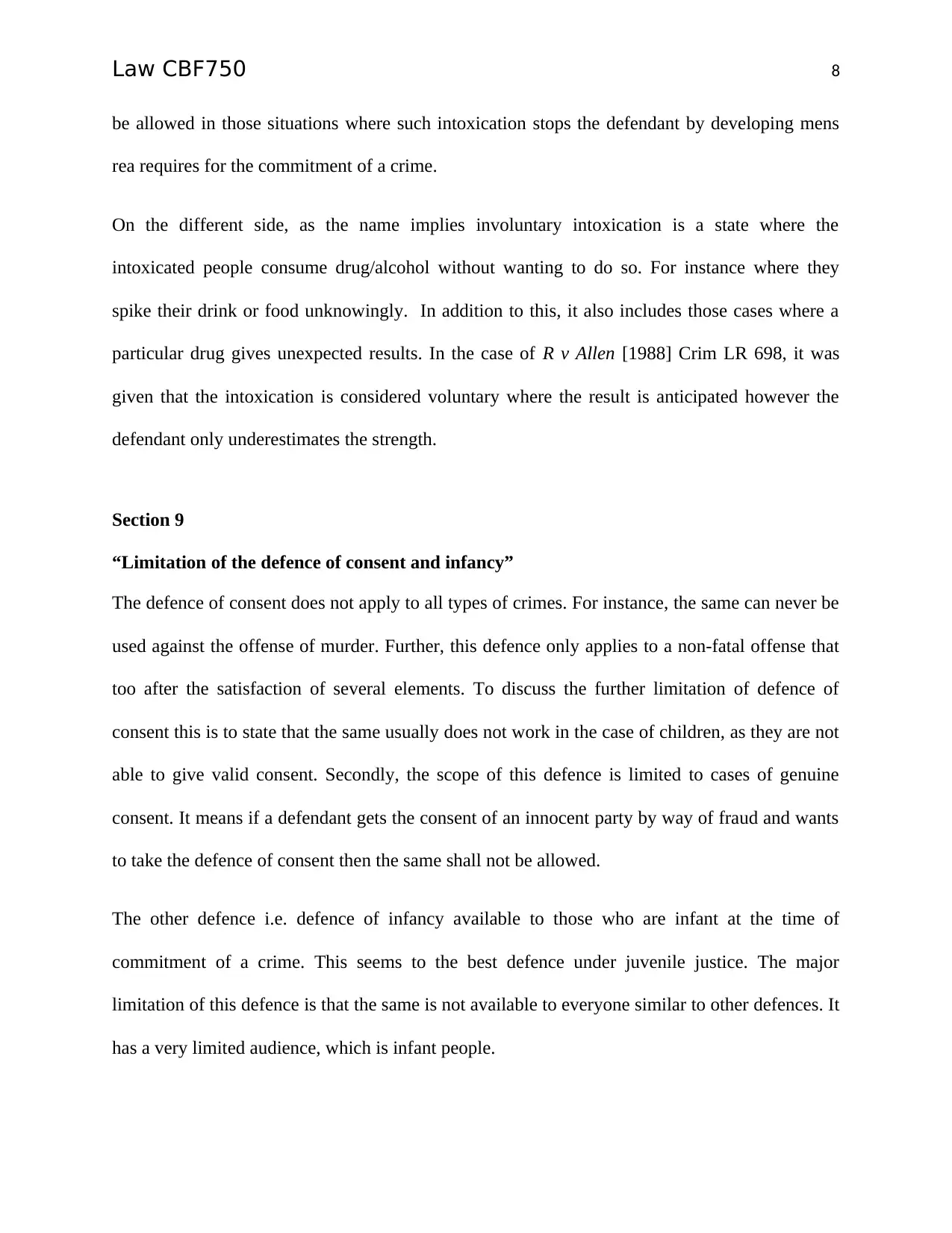
Law CBF750 8
be allowed in those situations where such intoxication stops the defendant by developing mens
rea requires for the commitment of a crime.
On the different side, as the name implies involuntary intoxication is a state where the
intoxicated people consume drug/alcohol without wanting to do so. For instance where they
spike their drink or food unknowingly. In addition to this, it also includes those cases where a
particular drug gives unexpected results. In the case of R v Allen [1988] Crim LR 698, it was
given that the intoxication is considered voluntary where the result is anticipated however the
defendant only underestimates the strength.
Section 9
“Limitation of the defence of consent and infancy”
The defence of consent does not apply to all types of crimes. For instance, the same can never be
used against the offense of murder. Further, this defence only applies to a non-fatal offense that
too after the satisfaction of several elements. To discuss the further limitation of defence of
consent this is to state that the same usually does not work in the case of children, as they are not
able to give valid consent. Secondly, the scope of this defence is limited to cases of genuine
consent. It means if a defendant gets the consent of an innocent party by way of fraud and wants
to take the defence of consent then the same shall not be allowed.
The other defence i.e. defence of infancy available to those who are infant at the time of
commitment of a crime. This seems to the best defence under juvenile justice. The major
limitation of this defence is that the same is not available to everyone similar to other defences. It
has a very limited audience, which is infant people.
be allowed in those situations where such intoxication stops the defendant by developing mens
rea requires for the commitment of a crime.
On the different side, as the name implies involuntary intoxication is a state where the
intoxicated people consume drug/alcohol without wanting to do so. For instance where they
spike their drink or food unknowingly. In addition to this, it also includes those cases where a
particular drug gives unexpected results. In the case of R v Allen [1988] Crim LR 698, it was
given that the intoxication is considered voluntary where the result is anticipated however the
defendant only underestimates the strength.
Section 9
“Limitation of the defence of consent and infancy”
The defence of consent does not apply to all types of crimes. For instance, the same can never be
used against the offense of murder. Further, this defence only applies to a non-fatal offense that
too after the satisfaction of several elements. To discuss the further limitation of defence of
consent this is to state that the same usually does not work in the case of children, as they are not
able to give valid consent. Secondly, the scope of this defence is limited to cases of genuine
consent. It means if a defendant gets the consent of an innocent party by way of fraud and wants
to take the defence of consent then the same shall not be allowed.
The other defence i.e. defence of infancy available to those who are infant at the time of
commitment of a crime. This seems to the best defence under juvenile justice. The major
limitation of this defence is that the same is not available to everyone similar to other defences. It
has a very limited audience, which is infant people.
⊘ This is a preview!⊘
Do you want full access?
Subscribe today to unlock all pages.

Trusted by 1+ million students worldwide

Law CBF750 9
Conclusion
To conclude this report this is to state that although the criminal law offers a variety of defence,
yet they are not absolute and are subject to a range of requirements and limitations. Many
defences such as Duress of circumstances, defence of mistake, defence of insanity, Duress of
threats, defence of infancy and others have been discussed. Further, the applicability of defence
may vary as per the specific facts of the case.
Conclusion
To conclude this report this is to state that although the criminal law offers a variety of defence,
yet they are not absolute and are subject to a range of requirements and limitations. Many
defences such as Duress of circumstances, defence of mistake, defence of insanity, Duress of
threats, defence of infancy and others have been discussed. Further, the applicability of defence
may vary as per the specific facts of the case.
Paraphrase This Document
Need a fresh take? Get an instant paraphrase of this document with our AI Paraphraser
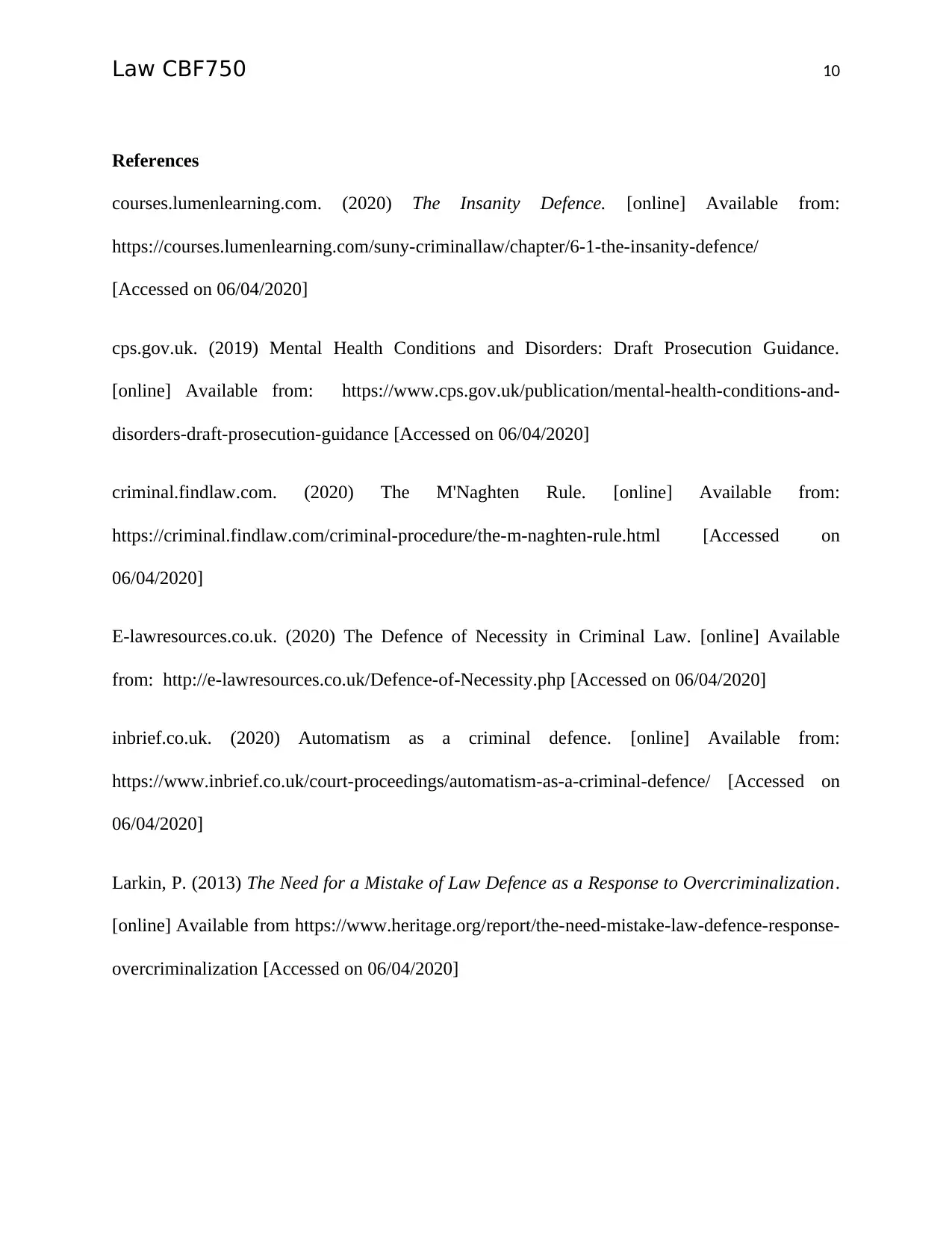
Law CBF750 10
References
courses.lumenlearning.com. (2020) The Insanity Defence. [online] Available from:
https://courses.lumenlearning.com/suny-criminallaw/chapter/6-1-the-insanity-defence/
[Accessed on 06/04/2020]
cps.gov.uk. (2019) Mental Health Conditions and Disorders: Draft Prosecution Guidance.
[online] Available from: https://www.cps.gov.uk/publication/mental-health-conditions-and-
disorders-draft-prosecution-guidance [Accessed on 06/04/2020]
criminal.findlaw.com. (2020) The M'Naghten Rule. [online] Available from:
https://criminal.findlaw.com/criminal-procedure/the-m-naghten-rule.html [Accessed on
06/04/2020]
E-lawresources.co.uk. (2020) The Defence of Necessity in Criminal Law. [online] Available
from: http://e-lawresources.co.uk/Defence-of-Necessity.php [Accessed on 06/04/2020]
inbrief.co.uk. (2020) Automatism as a criminal defence. [online] Available from:
https://www.inbrief.co.uk/court-proceedings/automatism-as-a-criminal-defence/ [Accessed on
06/04/2020]
Larkin, P. (2013) The Need for a Mistake of Law Defence as a Response to Overcriminalization.
[online] Available from https://www.heritage.org/report/the-need-mistake-law-defence-response-
overcriminalization [Accessed on 06/04/2020]
References
courses.lumenlearning.com. (2020) The Insanity Defence. [online] Available from:
https://courses.lumenlearning.com/suny-criminallaw/chapter/6-1-the-insanity-defence/
[Accessed on 06/04/2020]
cps.gov.uk. (2019) Mental Health Conditions and Disorders: Draft Prosecution Guidance.
[online] Available from: https://www.cps.gov.uk/publication/mental-health-conditions-and-
disorders-draft-prosecution-guidance [Accessed on 06/04/2020]
criminal.findlaw.com. (2020) The M'Naghten Rule. [online] Available from:
https://criminal.findlaw.com/criminal-procedure/the-m-naghten-rule.html [Accessed on
06/04/2020]
E-lawresources.co.uk. (2020) The Defence of Necessity in Criminal Law. [online] Available
from: http://e-lawresources.co.uk/Defence-of-Necessity.php [Accessed on 06/04/2020]
inbrief.co.uk. (2020) Automatism as a criminal defence. [online] Available from:
https://www.inbrief.co.uk/court-proceedings/automatism-as-a-criminal-defence/ [Accessed on
06/04/2020]
Larkin, P. (2013) The Need for a Mistake of Law Defence as a Response to Overcriminalization.
[online] Available from https://www.heritage.org/report/the-need-mistake-law-defence-response-
overcriminalization [Accessed on 06/04/2020]
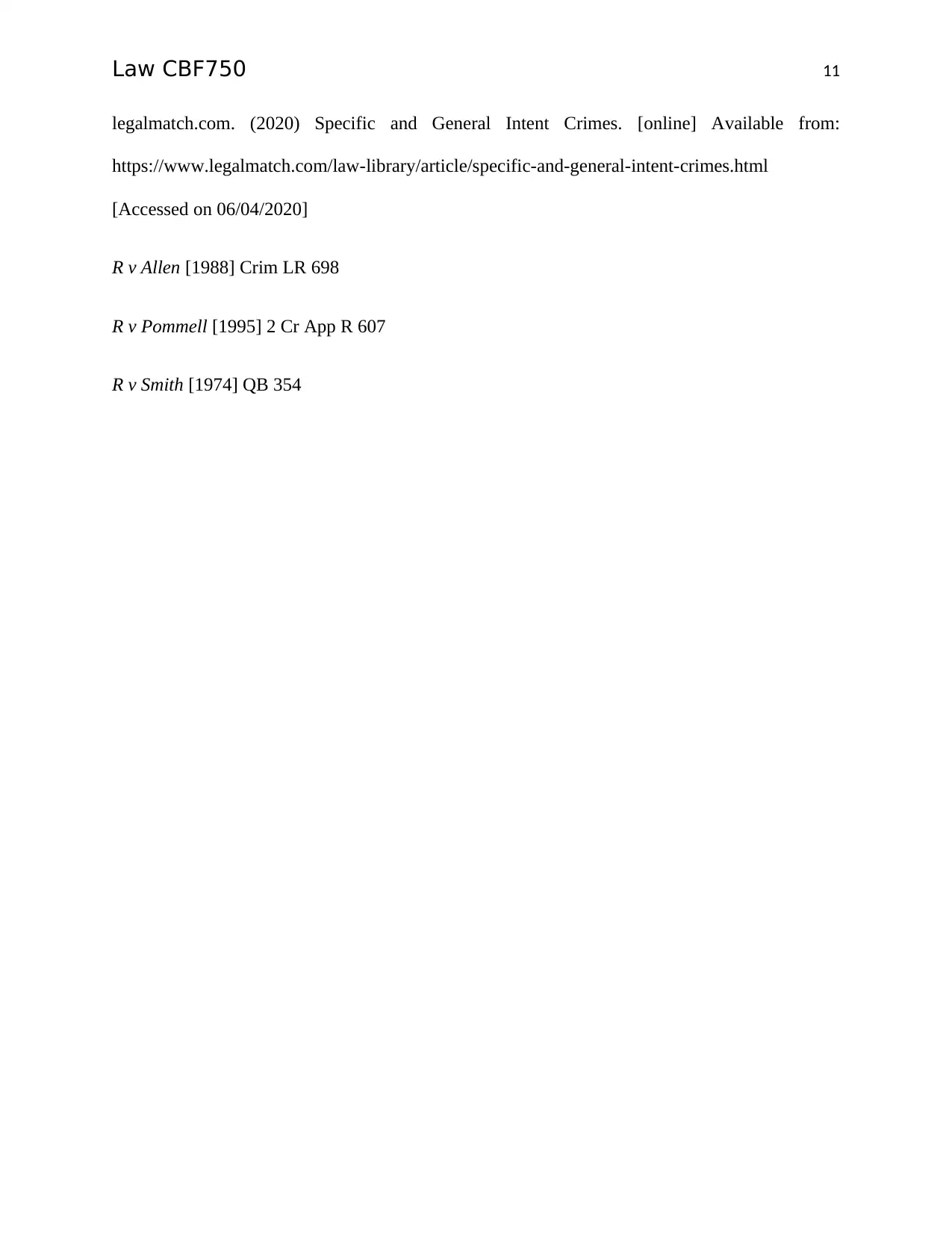
Law CBF750 11
legalmatch.com. (2020) Specific and General Intent Crimes. [online] Available from:
https://www.legalmatch.com/law-library/article/specific-and-general-intent-crimes.html
[Accessed on 06/04/2020]
R v Allen [1988] Crim LR 698
R v Pommell [1995] 2 Cr App R 607
R v Smith [1974] QB 354
legalmatch.com. (2020) Specific and General Intent Crimes. [online] Available from:
https://www.legalmatch.com/law-library/article/specific-and-general-intent-crimes.html
[Accessed on 06/04/2020]
R v Allen [1988] Crim LR 698
R v Pommell [1995] 2 Cr App R 607
R v Smith [1974] QB 354
⊘ This is a preview!⊘
Do you want full access?
Subscribe today to unlock all pages.

Trusted by 1+ million students worldwide
1 out of 12
Related Documents
Your All-in-One AI-Powered Toolkit for Academic Success.
+13062052269
info@desklib.com
Available 24*7 on WhatsApp / Email
![[object Object]](/_next/static/media/star-bottom.7253800d.svg)
Unlock your academic potential
Copyright © 2020–2025 A2Z Services. All Rights Reserved. Developed and managed by ZUCOL.





